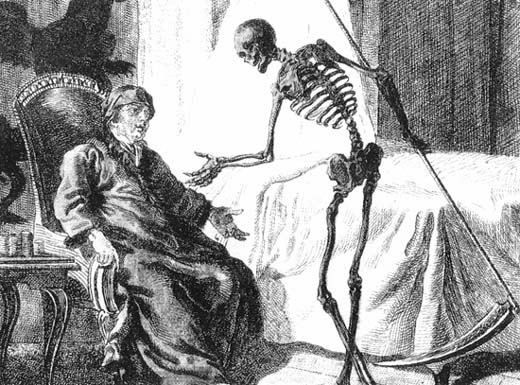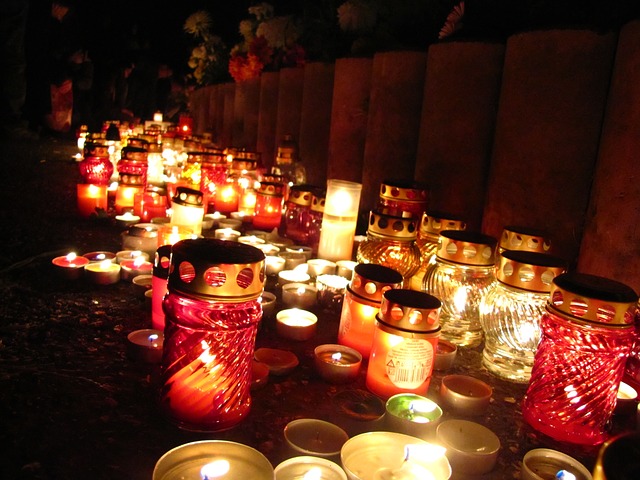 If a person searches the word ‘death’, artists’ renditions of the Grim Reaper appear on the screen—each one depicting a similar figure of a haunting, skeleton figure, enshrouded in a black cloak, drawing us forward with his scythe. These images of a decayed body, hiding beneath a cloak shape the idea of death as something frightening, a reminder of our mortality and the notion that one day we will leave our lives behind on Earth. Death remains the one collective experience that connects everyone together, yet it’s also an intangible idea we aren’t able to hold in our hands and fully grasp. Many look to religion for answers. Christians believe in an afterlife, while Buddhists hold the belief of reincarnation. Nevertheless, death—a fated journey inked into our skins—remains a taboo subject whispered, if at all, in conversations. How did something so natural become a fearful topic?
If a person searches the word ‘death’, artists’ renditions of the Grim Reaper appear on the screen—each one depicting a similar figure of a haunting, skeleton figure, enshrouded in a black cloak, drawing us forward with his scythe. These images of a decayed body, hiding beneath a cloak shape the idea of death as something frightening, a reminder of our mortality and the notion that one day we will leave our lives behind on Earth. Death remains the one collective experience that connects everyone together, yet it’s also an intangible idea we aren’t able to hold in our hands and fully grasp. Many look to religion for answers. Christians believe in an afterlife, while Buddhists hold the belief of reincarnation. Nevertheless, death—a fated journey inked into our skins—remains a taboo subject whispered, if at all, in conversations. How did something so natural become a fearful topic?
The Black Plague swept through town after town, killing roughly 25 million people in the first wave. The disease left the victims skin black, decrepit and covered with boils, inspiring artists to portray death as a skeleton. Death lived among them, as it was common to see another body stricken with disease on the streets.
 Different cultures characterize death in different ways. In Ancient Greece, death or Thantos, is depicted as a bearded, winged man, or even a young boy, helping people find their ways to the underworld. Mexico celebrates the Day of the Dead starting on October 31, and personifies La Santa Muerte or Saint Death as a woman. The holiday stresses the importance of remembering and praying for friends and family who have died. Death is not shaped as an evil figure calling us into oblivion in these instances. The frightening idea of death we often see in popular culture now from the third ghost in A Christmas Carol to The Simpsons originated from the Middle Ages. The Black Plague swept through town after town, killing roughly 25 million people in the first wave. The disease left the victims skin black, decrepit and covered with boils, inspiring artists to portray death as a skeleton. Death lived among them, as it was common to see another body stricken with disease on the streets. From this historical event, the swiftness and unpredictability of death led us to view death as something to fear.
Different cultures characterize death in different ways. In Ancient Greece, death or Thantos, is depicted as a bearded, winged man, or even a young boy, helping people find their ways to the underworld. Mexico celebrates the Day of the Dead starting on October 31, and personifies La Santa Muerte or Saint Death as a woman. The holiday stresses the importance of remembering and praying for friends and family who have died. Death is not shaped as an evil figure calling us into oblivion in these instances. The frightening idea of death we often see in popular culture now from the third ghost in A Christmas Carol to The Simpsons originated from the Middle Ages. The Black Plague swept through town after town, killing roughly 25 million people in the first wave. The disease left the victims skin black, decrepit and covered with boils, inspiring artists to portray death as a skeleton. Death lived among them, as it was common to see another body stricken with disease on the streets. From this historical event, the swiftness and unpredictability of death led us to view death as something to fear.
It’s important to remember, however, that this archaic idea of death stemmed from fear during a time when there was little sanitation and scientific research to explain the disease. In our modern world, with a plethora of scientific research and avenues to connect with each other, people are advocating to change our perspective of death.
It’s important to remember, however, that this archaic idea of death stemmed from fear during a time when there was little sanitation and scientific research to explain the disease. In our modern world, with a plethora of scientific research and avenues to connect with each other, people are advocating to change our perspective of death. Swiss sociologist Bernard Crettaz created the idea of a “Death Cafe,” where people have the chance to sit down to a cup of coffee and talk openly about death. From Switzerland to Paris and even in San Francisco, people gather together to talk about the one subject that used to be feared. Since September 2011, there have been over 1,075 Death Cafes. Even with social media, based on an article in The Atlantic, people’s willingness to share information online has the potential to change the way we view death as something healthy, natural and not whispered about in fear behind closed doors.
Read more perspectives about death in our former Cultural Perspectives.

 Breaking the Taboo of Death
Breaking the Taboo of Death


 “Other Side” Documents Woman’s Fight To Die As She Wishes
“Other Side” Documents Woman’s Fight To Die As She Wishes
 The Other Death in the Family
The Other Death in the Family















